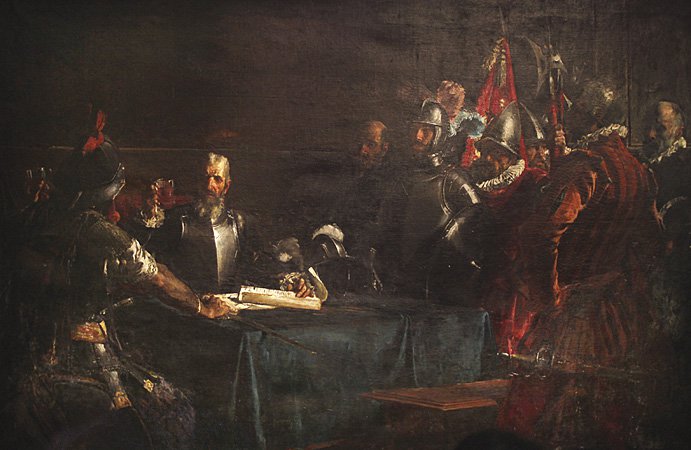Cultural Center of the Philippines
ENCYCLOPEDIA OF
PHILIPPINE ART
El Pacto de Sangre
(The Blood Compact) / 1885 / Oil on canvas / Approximately 200 x 300 cm / Artist: Juan Luna / Malacañan Palace collection
In return for the pension received from the Manila City government while studying at the Academia de San Fernando in Madrid, Luna was supposed to send several canvases to Manila. Among this was El Pacto de Sangre. Luna chose to paint this mural partly to delineate the goodwill between the Spanish colonial administration and partly to favorably portray Filipino culture. Having done research in indigenous culture, Luna depicted Sikatuna’s dagger, cup, mail vestment, and salakot (woven hat) to highlight the sophistication of native culture at the time of Spanish arrival.
The subject refers to the pledge of friendship undertaken on 16 Mar 1565 by Sikatuna and Miguel Lopez de Legazpi. Sikatuna is depicted at the lower left corner of the painting, with his back turned to the viewer; Legazpi, at left near center, faces Sikatuna. At the right of the picture is Fray Andres de Urdaneta, the Augustinian priest who also served as navigator of Legazpi’s expedition. Right of Urdaneta, in full armor, is the youthful Felipe de Salcedo, a nephew of Legazpi. The patriot Jose Rizal, an intimate friend of Juan Luna, posed as Sikatuna while Trinidad Pardo de Tavera, the painter’s then-future brother-in-law, sat as Legaspi.
Luna’s treatment of El Pacto de Sangre adverts to pictorial skills he used in Spoliarium, his gold medal-winning entry the previous year. Dramatic contrast of light and shadow enhances the metallic textures of the breastplates and helmets of the Spanish soldiers and the accessories in Sikatuna’s dress. It also establishes a formal, almost tense atmosphere. Brilliant, chromatically rich hues, like red, silvery blue, and rich blue green, likewise intensify the solemnity of the ceremony. As in Spoliarium, the figures are not evenly distributed; thus tension rather than serenity is evoked. The obvious asymmetricality is neutralized, chiefly by the presence of white and glinting objects on the right like the scroll on the table, Legazpi’s breastplate, and Sikatuna’s adornments.
Written by Santiago A. Pilar
